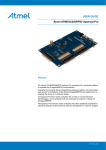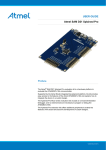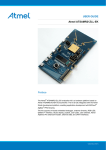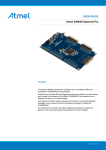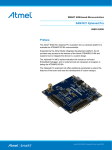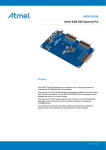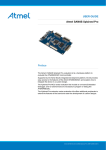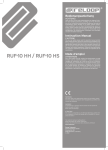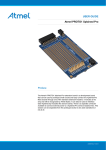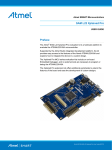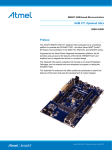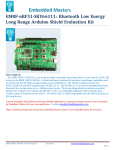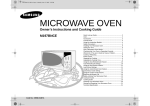Download Atmel ATMEGA256RFR2 Xplained Pro (USER
Transcript
USER GUIDE Atmel ATMEGA256RFR2 Xplained Pro Preface The Atmel® ATMEGA256RFR2 Xplained Pro evaluation kit is hardware platform to evaluate the ATmega256RFR2 microcontroller. Supported by the Atmel Studio integrated development platform, the kit provides easy access to the features of the Atmel ATmega256RFR2 and explains how to integrate the device in a customer design. The Xplained Pro MCU series evaluation kits include an on-board Embedded Debugger, and no external tools are necessary to program or debug the ATmega256RFR2. The Xplained Pro extension series evaluation kits offers additional peripherals to extend the features of the board and ease the development of customer designs. 42079D-MCU-12/2013 Table of Contents Preface .......................................................................................... 1 1. Introduction .............................................................................. 3 1.1. 1.2. Features .............................................................................. 3 Kit overview ......................................................................... 3 2. Getting started ......................................................................... 5 2.1. 2.2. 2.3. Quick-start ........................................................................... 5 Connecting the kit ................................................................. 5 Design documentation and related links ..................................... 5 3. Xplained Pro ............................................................................ 6 3.1. 3.2. 3.3. 3.4. Embedded Debugger ............................................................. 6 Hardware identification system ................................................. 6 Power supply ....................................................................... 7 3.3.1. Measuring ATmega256RFR2 power consumption ............ 7 Standard headers and connectors ............................................ 7 3.4.1. Xplained Pro Standard Extension Header ...................... 7 3.4.2. Xplained Pro power header ......................................... 8 4. Hardware user guide ............................................................ 10 4.1. 4.2. 4.3. 4.4. Connectors ......................................................................... 4.1.1. I/O extension headers .............................................. 4.1.2. Other headers ........................................................ Peripherals ......................................................................... 4.2.1. Crystals ................................................................. 4.2.2. Mechanical buttons .................................................. 4.2.3. LED ...................................................................... 4.2.4. RF ........................................................................ 4.2.5. Temperature sensor ................................................. Embedded Debugger implementation ...................................... 4.3.1. JTAG ..................................................................... 4.3.2. Virtual COM port ..................................................... 4.3.3. Atmel Data Gateway Interface ................................... Factory programmed data ..................................................... 10 10 13 14 14 14 14 14 15 15 15 16 16 16 5. Persistent Memory ................................................................ 18 6. Agency Certification .............................................................. 19 6.1. 6.2. 6.3. UNITED STATES (FCC) ....................................................... 19 European Union (ETSI) ........................................................ 19 List of Antennae tested with this product: ................................. 20 7. Hardware revision history and known issues ........................ 21 7.1. 7.2. Identifying Product ID and Revision ......................................... 21 Revision 3 .......................................................................... 21 8. Document revision history ..................................................... 22 9. Evaluation board/kit important notice .................................... 23 Atmel ATMEGA256RFR2 Xplained Pro [USER GUIDE] 42079D-MCU-12/2013 2 1. Introduction 1.1 Features ● Atmel® ATmega256RFR2 microcontroller ● Embedded Debugger (EDBG) ● ● 1.2 ● USB interface ● Programming and debugging (target) through JTAG ● Virtual COM-port interface to target via UART ● Atmel Data Gateway Interface (DGI) to target via SPI or TWI ● Four GPIOs connected to target for code instrumentation Digital I/O ● Two mechanical buttons (user and reset button) ● One user LED ● Five extension headers Antenna ● One ceramic chip antenna (2450BM15A0015E) ● One SMA connector for external antenna ● Temperature sensor and EEPROM (AT30TSE758) ● Two possible power sources ● External power ● Embedded debugger USB ● 16MHz crystal ● 32kHz crystal Kit overview The Atmel ATMEGA256RFR2 Xplained Pro evaluation kit is a hardware platform to evaluate the Atmel ATmega256RFR2. The kit offers a set of features that enables the ATmega256RFR2 user to get started using the ATmega256RFR2 peripherals right away and to get an understanding of how to integrate the device in their own design. Atmel ATMEGA256RFR2 Xplained Pro [USER GUIDE] 42079D-MCU-12/2013 3 Figure 1-1. ATMEGA256RFR2 Xplained Pro evaluation kit overview. Atmel ATMEGA256RFR2 Xplained Pro [USER GUIDE] 42079D-MCU-12/2013 4 2. Getting started 2.1 Quick-start 3 Steps to start exploring the Atmel Xplained Pro Platform 2.2 1 ● Download and install Atmel Studio ● Launch Atmel Studio ● Connect a USB micro B cable to the DEBUG USB port Connecting the kit When connecting Atmel ATMEGA256RFR2 Xplained Pro to your computer for the first time, the operating system will do a driver software installation. The driver file supports both 32-bit and 64-bit versions of Microsoft® Windows® XP and Windows 7. Once connected the green power LED will be lit and Atmel Studio will autodetect which Xplained Pro evaluation- and extension kit(s) that's connected. You'll be presented with relevant information like datasheets and kit documentation. You also have the option to launch Atmel Software Framework (ASF) example applications. The target device is programmed and debugged by the on-board Embedded Debugger and no 2 external programmer or debugger tool is needed. Please refer to the Atmel Studio user guide for information regarding how to compile and program the kit. 2.3 Design documentation and related links The following list contains links to the most relevant documents and software for the ATMEGA256RFR2 Xplained Pro. 3 1. Xplained Pro products - Atmel Xplained Pro is a series of small-sized and easy-to-use evaluation kits for 8- and 32-bit Atmel microcontrollers. It consists of a series of low cost MCU boards for evaluation and demonstration of features and capabilities of different MCU families. 2. ATMEGA256RFR2 Xplained Pro User Guide - PDF version of this User Guide. 3. ATMEGA256RFR2 Xplained Pro Design Documentation - Package containing schematics, BOM, assembly drawings, 3D plots, layer plots etc. 4. Atmel Studio - Free Atmel IDE for development of C/C++ and assembler code for Atmel microcontrollers. 5. IAR Embedded Workbench® for Atmel AVR®. This is a commercial C/C++ compiler that is available for 8-bit AVR. There is a 30 day evaluation version as well as a 4k code size limited kick-start version available from their website. 6. Atmel sample store - Atmel sample store where you can order samples of devices. 4 5 6 7 8 1 http://www.atmel.com/atmelstudio http://www.atmel.com/atmelstudio http://www.atmel.com/XplainedPro 4 http://www.atmel.com/Images/Atmel-42079-ATMEGA256RFR2-Xplained-Pro_User-Guide.pdf 5 http://www.atmel.com/Images/Atmel-42079-ATMEGA256RFR2-Xplained-Pro_User-Guide.zip 6 http://www.atmel.com/atmelstudio 7 http://www.iar.com/en/Products/IAR-Embedded-Workbench/AVR/ 8 http://www.atmel.com/system/samplesstore 2 3 Atmel ATMEGA256RFR2 Xplained Pro [USER GUIDE] 42079D-MCU-12/2013 5 3. Xplained Pro Xplained Pro is an evaluation platform that provides the full Atmel microcontroller experience. The platform consists of a series of Microcontroller (MCU) boards and extension boards that are integrated with Atmel Studio, have Atmel Software Framework (ASF) drivers and demo code, support data streaming and more. Xplained Pro MCU boards support a wide range of Xplained Pro extension boards that are connected through a set of standardized headers and connectors. Each extension board has an identification (ID) chip to uniquely identify which boards are mounted on a Xplained Pro MCU board. This information is used to present relevant user guides, application notes, datasheets and example code through Atmel Studio. Available Xplained Pro 1 MCU and extension boards can be purchased in the Atmel Web Store . 3.1 Embedded Debugger The ATMEGA256RFR2 Xplained Pro contains the Atmel Embedded Debugger (EDBG) for on-board debugging. The EDBG is a composite USB device of 3 interfaces; a debugger, Virtual COM Port and Data Gateway Interface (DGI). In conjunction with Atmel Studio, the EDBG debugger interface can program and debug the ATmega256RFR2. On the ATMEGA256RFR2 Xplained Pro, the JTAG interface is connected between the EDBG and the ATmega256RFR2. The Virtual COM Port is connected to a UART port on the ATmega256RFR2 (see section “Embedded Debugger implementation” on page 15 for pinout), and provides an easy way to communicate with the target application through simple terminal software. It offers variable baud rate, parity and stop bit settings. Note that the settings on the target device UART must match the settings given in the terminal software. The DGI consists of several physical data interfaces for communication with the host computer. Please, see section “Embedded Debugger implementation” on page 15 for available interfaces and pinout. Communication over the interfaces are bidirectional. It can be used to send events and values from the ATmega256RFR2, or as a generic printf-style data channel. Traffic over the interfaces can be timestamped on the EDBG for more accurate tracing of events. Note that timestamping imposes an overhead that reduces maximal throughput. The DGI uses a proprietary protocol, and is thus only compatible with Atmel Studio. The EDBG controls two LEDs on ATMEGA256RFR2 Xplained Pro, a power LED and a status LED. Table 3-1, “EDBG LED control” on page 6 shows how the LEDs are controlled in different operation modes. Table 3-1. EDBG LED control Operation mode Power LED Status LED Normal operation Power LED is lit when power is applied to the board. Activity indicator, LED flashes every time something happens on the EDBG. Bootloader mode (idle) The power LED and the status LED blinks simultaneously. Bootloader mode (firmware upgrade) The power LED and the status LED blinks in an alternating pattern. 2 For further documentation on the EDBG, see the EDBG User Guide . 3.2 Hardware identification system All Xplained Pro compatible extension boards have an Atmel ATSHA204 CryptoAuthentication™ chip mounted. This chip contains information that identifies the extension with its name and some extra data. When an Xplained Pro extension board is connected to an Xplained Pro MCU board the information is read and sent to Atmel Studio. The Atmel Kits extension, installed with Atmel Studio, will give relevant information, code examples and links to relevant documents. Table 3-2, “Xplained Pro ID Chip Content” on page 6 shows the data fields stored in the ID chip with example content. Table 3-2. Xplained Pro ID Chip Content 1 2 Data Field Data Type Example Content Manufacturer ASCII string Atmel’\0’ Product Name ASCII string Segment LCD1 Xplained Pro’\0’ http://store.atmel.com/ http://www.atmel.com/Images/Atmel-42096-Microcontrollers-Embedded-Debugger_User-Guide.pdf Atmel ATMEGA256RFR2 Xplained Pro [USER GUIDE] 42079D-MCU-12/2013 6 3.3 Data Field Data Type Example Content Product Revision ASCII string 02’\0’ Product Serial Number ASCII string 1774020200000010’\0’ Minimum Voltage [mV] uint16_t 3000 Maximum Voltage [mV] uint16_t 3600 Maximum Current [mA] uint16_t 30 Power supply The ATMEGA256RFR2 Xplained Pro kit can be powered either by USB or by an external power source through the 4-pin power header, marked PWR. This connector is described in “Xplained Pro power header” on page 8. The available power sources and specifications are listed in Table 3-3, “Power sources for ATMEGA256RFR2 Xplained Pro” on page 7. Table 3-3. Power sources for ATMEGA256RFR2 Xplained Pro Power input Voltage requirements Current requirements Connector marking External power 4.3V to 5.5V Recommended minimum is 500mA to be able to provide enough current for extentions and the board itself. Recommended maximum is 2A due to the input protection maximum current specification. PWR Embedded debugger USB 4.4V to 5.25V (according to USB spec) 500 mA (according to USB spec) DEBUG USB The kit will automatically detect which power sources are available and choose which one to use according to the following priority: 3.3.1 1. External power 2. Embedded debugger USB Measuring ATmega256RFR2 power consumption As part of an evaluation of the ATmega256RFR2 it can be of interest to measure its power consumption. Because the device has a separate power plane (VCC_MCU_P3V3) on this board it is possible to measure the current consumption by measuring the current that is flowing into this plane. The VCC_MCU_P3V3 plane is connected via a jumper to the main power plane (VCC_TARGET_P3V3) and by replacing the jumper with an ampere meter it is possible to determine the current consumption. To locate the current measurement header, please refer to Figure 1-1, “ATMEGA256RFR2 Xplained Pro evaluation kit overview.” on page 4. Warning Do not power the board without having the jumper or an ampere meter mounted. This can cause the ATmega256RFR2 to be powered through its I/O pins and cause undefined operation of the device. 3.4 Standard headers and connectors 3.4.1 Xplained Pro Standard Extension Header All Xplained Pro kits have one or more dual row, 20-pin, 100mil extension headers. Xplained Pro MCU boards have male headers while Xplained Pro extensions have their female counterparts. Note that all pins are not always connected. However, all the connected pins follow the defined pin-out described in Table 3-4, “Xplained Pro Extension Header” on page 8. The extension headers can be used to connect a wide variety of Atmel ATMEGA256RFR2 Xplained Pro [USER GUIDE] 42079D-MCU-12/2013 7 Xplained Pro extensions to Xplained Pro MCU boards and to access the pins of the target MCU on Xplained Pro MCU board directly. Table 3-4. Xplained Pro Extension Header 3.4.2 Pin number Name Description 1 ID Communication line to the ID chip on extension board. 2 GND Ground. 3 ADC(+) Analog to digital converter , alternatively positive part of differential ADC. 4 ADC(-) Analog to digital converter , alternatively negative part of differential ADC. 5 GPIO1 General purpose I/O. 6 GPIO2 General purpose I/O. 7 PWM(+) Pulse width modulation , alternatively positive part of differential PWM. 8 PWM(-) Pulse width modulation , alternatively positive part of differential PWM. 9 IRQ/GPIO Interrupt request line and/or general purpose I/O. 10 SPI_SS_B/GPIO Slave select for SPI and/or general purpose I/O. 11 TWI_SDA Data line for two-wire interface. Always implemented, bus type. 12 TWI_SCL Clock line for two-wire interface. Always implemented, bus type. 13 USART_RX Receiver line of Universal Synchronous and Asynchronous serial Receiver and Transmitter. 14 USART_TX Transmitter line of Universal Synchronous and Asynchronous serial Receiver and Transmitter. 15 SPI_SS_A Slave select for SPI. Should be unique if possible. 16 SPI_MOSI Master out slave in line of Serial peripheral interface. Always implemented, bus type. 17 SPI_MISO Master in slave out line of Serial peripheral interface. Always implemented, bus type. 18 SPI_SCK Clock for Serial peripheral interface. Always implemented, bus type. 19 GND Ground. 20 VCC Power for extension board. Xplained Pro power header The power header can be used to connect external power to the ATMEGA256RFR2 Xplained Pro kit. The kit will automatically detect and switch to the external power if supplied. The power header can also be used as supply for external peripherals or extension boards. Care must be taken not to exceed the total current limitation of the on-board regulator for the 3.3V regulated output. To locate the current measurement header, please refer to Figure 1-1, “ATMEGA256RFR2 Xplained Pro evaluation kit overview.” on page 4 Table 3-5. Power header PWR Pin number PWR header Pin name Description 1 VEXT_P5V0 External 5V input 2 GND Ground 3 VCC_P5V0 Unregulated 5V (output, derived from one of the input sources) 4 VCC_P3V3 Regulated 3.3V (output, used as main power for the kit) Atmel ATMEGA256RFR2 Xplained Pro [USER GUIDE] 42079D-MCU-12/2013 8 Note If the board is powered from a battery source it is recommended to use the PWR header. If there is a power source connected to EDBG USB, the EDBG is activated and it will consume more power. Atmel ATMEGA256RFR2 Xplained Pro [USER GUIDE] 42079D-MCU-12/2013 9 4. Hardware user guide 4.1 Connectors This chapter describes the implementation of the relevant connectors and headers on ATMEGA256RFR2 Xplained Pro and their connection to the ATmega256RFR2. The tables of connections in this chapter also describes which signals are shared between the headers and on-board functionality. 4.1.1 I/O extension headers The ATMEGA256RFR2 Xplained Pro headers EXT1, EXT2, EXT3, EXT4 and EXT5 offers access to the I/ O of the microcontroller in order to expand the board e.g. by connecting extension modules to the board. These headers all comply with the standard extension header specified in Xplained Pro Standard Extension Header on page 7. All headers have a pitch of 2.54 mm. Table 4-1. Extension header EXT1 Pin on EXT1 ATmega256RFR2 pin Function 1 Communication line to ID chip on extension board. 2 GND Shared functionality 3 PF0 ADC0 4 PF1 ADC1 5 PE2 GPIO 6 PE3 GPIO 7 PB5 OC1A 8 PB6 OC1B 9 PE5 GPIO / INT5 EXT4 header. 10 PD5 GPIO / SPI chip select B EXT4 header. 11 PD1 TWI SDA All EXT headers. 12 PD0 TWI SCL All EXT headers. 13 PE0 UART0 RXD All EXT headers. EXT2, EXT3 and EXT5 connected through cutstrap. 14 PE1 UART0 TXD All EXT headers. EXT2, EXT3 and EXT5 connected through cutstrap. 15 PG0 GPIO / SPI chip select A EXT4 header. 16 PB2 SPI MOSI All EXT headers. 17 PB3 SPI MISO All EXT headers. 18 PB1 SPI SCK All EXT headers. 19 GND 20 VCC EXT4 header. Table 4-2. Extension header EXT2 Pin on EXT2 ATmega256RFR2 pin Function 1 Communication line to ID chip on extension board. 2 GND Shared functionality Atmel ATMEGA256RFR2 Xplained Pro [USER GUIDE] 42079D-MCU-12/2013 10 Pin on EXT2 ATmega256RFR2 pin Function Shared functionality 9 PE6 GPIO / INT6 EXT5 header. 10 PD6 GPIO / SPI chip select B EXT5 header. 11 PD1 TWI SDA All other EXT headers. 12 PD0 3 4 5 6 7 8 TWI SCL All other EXT headers. UART0 RXD All other EXT headers. EXT2, EXT3 and EXT5 connected through cutstrap. UART0 TXD All other EXT headers. EXT2, EXT3 and EXT5 connected through cutstrap. 13 PE0 1 14 PE1 1 15 PD4 GPIO / SPI chip select A EXT5 header. 16 PB2 SPI MOSI All other EXT headers. 17 PB3 SPI MISO All other EXT headers. 18 PB1 SPI SCK All other EXT headers. 19 GND 20 Notes: VCC 1 Connected through cut-strap Table 4-3. Extension header EXT3 Pin on EXT3 ATmega256RFR2 pin Function 1 Communication line to ID chip on extension board. 2 GND Shared functionality 3 PF3 GPIO 4 PG5 GPIO 5 PB7 GPIO 9 PE7 GPIO / INT7 10 PD7 GPIO / SPI chip select B 11 PD1 TWI SDA All other EXT headers. 12 PD0 6 7 8 13 PE0 1 14 PE1 1 TWI SCL All other EXT headers. UART0 RXD All other EXT headers. EXT2, EXT3 and EXT5 connected through cutstrap. UART0 TXD All other EXT headers. EXT2, EXT3 and EXT5 Atmel ATMEGA256RFR2 Xplained Pro [USER GUIDE] 42079D-MCU-12/2013 11 Pin on EXT3 ATmega256RFR2 pin Function 15 PG4 GPIO / SPI chip select A 16 PB2 SPI MOSI All other EXT headers. 17 PB3 SPI MISO All other EXT headers. 18 PB1 SPI SCK All other EXT headers. 19 GND 20 VCC Notes: Shared functionality connected through cutstrap. 1 Connected through cut-strap Table 4-4. Extension header EXT4 Pin on EXT4 ATmega256RFR2 pin Function 1 Communication line to ID chip on extension board. 2 GND Shared functionality 3 4 5 6 7 PB5 OC1A EXT1 header. 9 PE5 GPIO / INT5 EXT1 header. 10 PG0 GPIO / SPI chip select B EXT1 header. 11 PD1 TWI SDA All other EXT headers. 12 PD0 TWI SCL All other EXT headers. 13 PE0 UART0 RXD All other EXT headers. EXT2, EXT3 and EXT5 connected through cutstrap. 14 PE1 UART0 TXD All other EXT headers. EXT2, EXT3 and EXT5 connected through cutstrap. 15 PD5 GPIO / SPI chip select A EXT1 header. 16 PB2 SPI MOSI All other EXT headers. 17 PB3 SPI MISO All other EXT headers. 18 PB1 SPI SCK All other EXT headers. 8 19 GND 20 VCC Table 4-5. Extension header EXT5 Pin on EXT5 ATmega256RFR2 pin Function 1 Communication line to ID chip on extension board. 2 GND Shared functionality 3 Atmel ATMEGA256RFR2 Xplained Pro [USER GUIDE] 42079D-MCU-12/2013 12 Pin on EXT5 ATmega256RFR2 pin Function Shared functionality 9 PE6 GPIO / INT6 EXT2 header. 10 PD4 GPIO / SPI chip select B EXT2 header. 11 PD1 TWI SDA All other EXT headers. 12 PD0 4 5 6 7 8 All other EXT headers. UART0 RXD All other EXT headers. EXT2, EXT3 and EXT5 connected through cutstrap. UART0 TXD All other EXT headers. EXT2, EXT3 and EXT5 connected through cutstrap. 13 PE0 14 PE1 1 15 PD6 GPIO / SPI chip select A EXT2 header. 16 PB2 SPI MOSI All other EXT headers. 17 PB3 SPI MISO All other EXT headers. 18 PB1 SPI SCK All other EXT headers. 19 GND 20 Notes: 4.1.2 TWI SCL 1 VCC 1 Connected through cut-strap Other headers In addition to the “I/O extension headers” on page 10, ATMEGA256RFR2 Xplained Pro has additionally two headers with spare signals which offers access to the I/O of the microcontroller which are otherwise not easily available elsewhere or might be favourable to have collected toghether. All headers have a pitch of 2.54mm. Table 4-6. SPARE ADC signals header Pin on header ATmega256RFR2 pin Function 1 - VCC (3.3V) 2 PF4 ADC4 3 PF5 4 PF6 5 Notes: PF7 Shared functionality 1 JTAG Interface, TCK 1 JTAG Interface, TMS 1 JTAG Interface, TDO 1 JTAG Interface, TDI ADC5 ADC6 ADC7 1 These lines are connected to the JTAG interface, and ADC will not work properly while debugging or programming the kit. Table 4-7. SPARE signals header 2 Pin on header ATmega256RFR2 pin Function 1 AREF Analog reference 2 TST Test pin for RF test mode 3 RSTN Reset 4 RSTON Reset status 5 CLKI Alternative main clock input Shared functionality EDBG and RESET button Atmel ATMEGA256RFR2 Xplained Pro [USER GUIDE] 42079D-MCU-12/2013 13 Pin on header ATmega256RFR2 pin 6 4.2 Peripherals 4.2.1 Crystals Function Shared functionality GND The ATMEGA256RFR2 Xplained Pro kit contains two crystals that can be used as clock sources for the ATmega256RFR2 device. Each crystal has a cut-strap next to it that can be used to measure the oscillator allowance. This is done by cutting the strap and adding a resistor across the strap. More information about 1 oscillator allowance and safety factor can be found in appnote AVR4100 Table 4-8. External 32.768kHz crystals Pin on ATmega256RFR2 Function PG3 TOSC2, crystal output PG4 TOSC1, crystal input Table 4-9. External 16MHz crystals 4.2.2 Pin on ATmega256RFR2 Function XTAL1 Crystal input XTAL2 Crystal output Mechanical buttons ATMEGA256RFR2 Xplained Pro contains two mechanical buttons. One button is the RESET button connected to the ATmega256RFR2 reset line and the other is a generic user configurable button. When a button is pressed it will drive the I/O line to GND. Table 4-10. Mechanical buttons 4.2.3 Pin on ATmega256RFR2 Silkscreen text RSTN RESET PE4 SW0 LED There is one yellow LED available on the ATMEGA256RFR2 Xplained Pro board that can be turned on and off. The LED can be activated by driving the connected I/O line to GND. Table 4-11. LED connections 4.2.4 Pin on ATmega256RFR2 LED PB4 Yellow LED RF The main feature of ATMEGA256RFR2 Xplained Pro is to show the RF capability of the ATmega256RFR2 device. This device has bidirectional differential antenna pins, which are fed through a balun (Johanson 2 Technology, 2450BM15A0015 ) to create a single unbalanced output/input. This kit has a passive analog RF 3 switch (Skyworks Solutions Inc, AS222-92LF ) connected to the unbalanced output of the balun. The switch is driven by the DIG1 and DIG2 pins of the ATmega256RFR2 which feature Antenna Diversity to enable the device to automatically select the best signal from two antennas (can also be selected manually). The output 4 of the switch is connected to a ceramic chip antenna (Johanson Technology, 2540AT18D0100 ) and a SMA connector for external antennas. 1 http://www.atmel.com/images/doc8333.pdf http://www.johansontechnology.com/datasheets/balun-filter/2450BM15A0015.pdf http://www.skyworksinc.com/uploads/documents/200252C.pdf 4 http://www.johansontechnology.com/images/stories/ip/rf-antennas/Antenna_2450AT18D0100_v3.pdf 2 3 Atmel ATMEGA256RFR2 Xplained Pro [USER GUIDE] 42079D-MCU-12/2013 14 Table 4-12. RF connections Pin on ATmega256RFR2 4.2.5 RFP RF balanced output (Positive) RFN RF balanced output (Negative) Temperature sensor ATMEGA256RFR2 Xplained Pro features an Atmel AT30TSE758 temperature sensor chip with an 8kbit serial EEPROM inside. The sensor includes programmable high and low temperature alarms, user-selectable temperature resolution up to 12 bits, and an I2C/SMBus™ compatible serial interface. Table 4-13. Temperature sensor connections. AT30TSE758 temperature sensor pin Pin name Pin on Comment ATmega256RFR2 1 SDA PD1 Data line of serial interface 2 SCL PD0 Clock line of serial interface 1 3 ALERT NC 4 GND GND 5 A2 - Addres line for serial interface, by default pulled low 6 A1 - Addres line for serial interface, by default pulled high 7 A0 - Addres line for serial interface, by default pulled high VCC VCC 8 Notes: Temperature alarm signalling pin 1 Alert pin is available on a testpoint hole close to the sensor. The temperature sensor has two TWI addresses, one for the temperature sensor and one for the EEPROM. The addresses are "0b1001 A2 A1 A0" for the temperature sensor and "0b1010 A2 A1 A0" for the EEPROM. The address selection lines (A2, A1 and A0) of the temperature sensor chip is by default pulled high for A0 and A1 and low for A2, through 100kΩ resistors, which makes the default addresses 0b1001011 and 0b1010011. Soldering the the straps on the front of the ATMEGA256RFR2 Xplained Pro board for An will alter that bit in the address to low or high. Each strap is marked in silkscreen with A0, A1 and A2 as shown in Figure 4-1, “Temperature sensor TWI address.” on page 15. When communicating with the EEPROM, part of the TWI 5 address is used as a page address, for more details see the device datasheet . Figure 4-1. Temperature sensor TWI address. 4.3 Embedded Debugger implementation The ATMEGA256RFR2 Xplained Pro contains an Embedded Debugger (EDBG) that can be used to program and debug the ATmega256RFR2 using JTAG. The Embedded Debugger also include a Virtual Com port interface over UART, an Atmel Data Gateway Interface over SPI and TWI and it monitors four of the ATmega256RFR2 GPIOs. Atmel Studio can be used as a front end for the Embedded Debugger. 4.3.1 JTAG The JTAG use five pins to communicate with the target. For further information on how to use the programming and debugging capabilities of the EDBG, see “Embedded Debugger” on page 6. 5 http://www.atmel.com/Images/doc8751.pdf Atmel ATMEGA256RFR2 Xplained Pro [USER GUIDE] 42079D-MCU-12/2013 15 Table 4-14. JTAG connections. 4.3.2 Pin on ATmega256RFR2 Function PF4 JTAG TCK PF5 JTAG TMS PF6 JTAG TDO PF7 JTAG TDI RSTN RESET Virtual COM port The Embedded Debugger act as a Virtual Com Port gateway by using one of the ATmega256RFR2 UARTs. For further information on how to use the Virtual COM port see “Embedded Debugger” on page 6. Table 4-15. Virtual COM port connections. 4.3.3 Pin on ATmega256RFR2 Function PD2 UART RXD (ATmega256RFR2 RX line) PD3 UART TXD (ATmega256RFR2 TX line) Atmel Data Gateway Interface The Embedded Debugger features an Atmel Data Gateway Interface (DGI) by using either a SPI or TWI port. The DGI can be used to send a variety of data from the ATmega256RFR2 to the host PC. For further information on how to use the DGI interface see “Embedded Debugger” on page 6. Table 4-16. DGI interface connections when using SPI. Pin on ATmega256RFR2 Function PB0 Slave select (ATmega256RFR2 is Master) PB1 SPI SCK (Clock Out) PB2 SPI MOSI (Master Out, Slave in) PB3 SPI MISO (Master In, Slave Out) Table 4-17. DGI interface connections when using TWI. Pin on ATmega256RFR2 Function PD0 SCL (Clock line) PD1 SDA (Data line) Four GPIO lines are connected to the Embedded Debugger. The EDBG can monitor these lines and time stamp pin value changes. This makes it possible to accurately time stamp events in the ATmega256RFR2 application code. For further information on how to configure and use the GPIO monitoring features see “Embedded Debugger” on page 6. Table 4-18. GPIO lines connected to the EDBG. 4.4 Pin on ATmega256RFR2 Function PE2 GPIO0 PE3 GPIO1 PE5 GPIO2 PE6 GPIO3 Factory programmed data ATMEGA256RFR2 Xplained Pro has preprogrammed data in the ATmega256RFR2's user signature data page 1 with address 0x0100. User signature data is isolated from the main flash and wil not be cleared by a chip erase command. Special commands are available to read, write and erase the user signature data pages through a JTAG interface and from firmware. Please refer to the ATmega256RFR2's datasheet for details on how to read the user signature data pages. Atmel ATMEGA256RFR2 Xplained Pro [USER GUIDE] 42079D-MCU-12/2013 16 The preprogrammed data in the user signature data page 1 is documented in “Persistent Memory” on page 18, ATMEGA256RFR2 Xplained Pro does not feature an XTAL calibration value. Atmel ATMEGA256RFR2 Xplained Pro [USER GUIDE] 42079D-MCU-12/2013 17 5. Persistent Memory A persistent memory space is allocated to store product specific information. The organization of the persistent memory is as follows: Table 5-1. Persistent Memory Data Data Type Size Structure Revision uint 16 2 bytes MAC address uint 64 Board information – PCBA Name 8 bytes 1 30 bytes 1 10 bytes 1 ASCII string Board information – PCBA Serial number ASCII string Board information – PCBA Atmel Part Number ASCII string 8 bytes Board information – PCBA Revision uint 8 1 byte Reserved 3 bytes XTAL Calibration Value uint 8 1 byte Reserved 7 bytes Reserved 4 bytes CRC Notes: uint 16 2 bytes 1 '\0' terminated ASCII string. The MAC address stored inside the MCU is a uniquely assigned ID for each kit and is owned by Atmel. User applications can use this unique MAC ID to address the kit. Atmel ATMEGA256RFR2 Xplained Pro [USER GUIDE] 42079D-MCU-12/2013 18 6. Agency Certification 6.1 UNITED STATES (FCC) This equipment complies with Part 15 of the FCC rules and regulations. To fulfill FCC Certification requirements, an OEM manufacturer must comply with the following regulations: 1. Important This equipment (ATMEGA256RFR2 Xplained Pro) is for use for evaluation purposes only and must not be incorporated into any other device or system. This equipment complies with Part 15 of the FCC Rules. Operation is subject to the following two conditions: (1) this device may not cause harmful interference, and (2) this device must accept any interference received, including interference that may cause undesired operation (FCC 15.19). The internal / external antenna(s) used for this mobile transmitter must provide a separation distance of at least 20 cm from all persons and must not be colocated or operating in conjunction with any other antenna or transmitter. Installers must be provided with antenna installation instructions and transmitter operating conditions for satisfying RF exposure compliance. This device is approved as a mobile device with respect to RF exposure compliance, and may only be marketed to OEM installers. Use in portable exposure conditions (FCC 2.1093) requires separate equipment authorization. Important Modifications not expressly approved by this company could void the user's authority to operate this equipment (FCC section 15.21). Important This equipment has been tested and found to comply with the limits for a Class A digital device, pursuant to Part 15 of the FCC Rules. These limits are designed to provide reasonable protection against harmful interference when the equipment is operated in a commercial environment. This equipment generates, uses, and can radiate radio frequency energy and, if not installed and used in accordance with the instruction manual, may cause harmful interference to radio communications. Operation of this equipment in a residential area is likely to cause harmful interference in which case the user will be required to correct the interference at his own expense (FCC section 15.105). 6.2 European Union (ETSI) The ATMEGA256RFR2 Xplained Pro Evaluation kits has been certified for use in European Union countries. A Declaration of Conformity must be issued for each of these standards and kept on file as described in Annex II of the R&TTE Directive. Furthermore, the manufacturer must maintain a copy of the modules' documentation and ensure the final product does not exceed the specified power ratings, antenna specifications, and/or installation requirements as specified in the user manual. If any of these specifications are exceeded in the final product, a submission must be made to a notified body for compliance testing to all required standards. Atmel ATMEGA256RFR2 Xplained Pro [USER GUIDE] 42079D-MCU-12/2013 19 Important The 'CE' marking must be affixed to a visible location on the OEM product. The CE mark shall consist of the initials "CE" taking the following form: ● The CE marking must have a height of at least 5mm except where this is not possible on account of the nature of the apparatus. ● The CE marking must be affixed visibly, legibly, and indelibly. More detailed information about CE marking requirements you can find at "DIRECTIVE 1999/5/ EC OF THE EUROPEAN PARLIAMENT AND OF THE COUNCIL" on 9 March 1999 at section 12. 6.3 List of Antennae tested with this product: Table 6-1. List of tested Antennae Antenna Number Make Model/Part # Antenna Gain (dBi) Type of Antenna Antenna 1 Johanson Technology 2450AT18D0100 1.5dBi Ceramic Antenna Antenna 2 Techfun Co., Ltd M01-SS2 0dBi External Antenna Atmel ATMEGA256RFR2 Xplained Pro [USER GUIDE] 42079D-MCU-12/2013 20 7. Hardware revision history and known issues 7.1 Identifying Product ID and Revision The revision and product identifier of Xplained Pro boards can be found in two ways, through Atmel Studio or by looking at the sticker on the bottom side of the PCB. By connecting a Xplained Pro MCU board to a computer with Atmel Studio running, an information window will pop up. The first six digits of the serial number, which is listed under kit details, contain the product identifier and revision. Information about connected Xplained Pro extension boards will also appear in the Atmel Kits window. The same information can be found on the sticker on the bottom side of the PCB. Most kits will print the identifier and revision in plain text as A09-nnnn\rr where nnnn is the identifier and rr is the revision. Boards with limited space have a sticker with only a QR-code which contains a serial number string. The serial number string has the following format: "nnnnrrssssssssss" n = product identifier r = revision s = serial number The kit identifier for ATMEGA256RFR2 Xplained Pro is 1784. 7.2 Revision 3 Revision 3 of ATMEGA256RFR2 Xplained Pro is the initial released version. ● The low and high byte of the 16-bit CRC value of the information in the user page might be swapped on serial numbers prior to 1885. Workaround: If it is neccssary to use the CRC value to verify the data in the user page, compare the calculated value with both the swapped and non-swapped version of the CRC value present in the user page. ● All kits with a serial number lower than 0200003858 does not have any pre programmed data in the userpage. Atmel ATMEGA256RFR2 Xplained Pro [USER GUIDE] 42079D-MCU-12/2013 21 8. Document revision history Document revision Date Comment 42079D 11/2013 Added chapter about persistent memory and factory programmed data. Added new errata. 42079C 21.05.2013 Added list of antennaes. 42079B 24.04.2013 Added section about certification. 42079A 25.02.2013 First release. Atmel ATMEGA256RFR2 Xplained Pro [USER GUIDE] 42079D-MCU-12/2013 22 9. Evaluation board/kit important notice This evaluation board/kit is intended for use for FURTHER ENGINEERING, DEVELOPMENT, DEMONSTRATION, OR EVALUATION PURPOSES ONLY. It is not a finished product and may not (yet) comply with some or any technical or legal requirements that are applicable to finished products, including, without limitation, directives regarding electromagnetic compatibility, recycling (WEEE), FCC, CE or UL (except as may be otherwise noted on the board/kit). Atmel supplied this board/kit "AS IS," without any warranties, with all faults, at the buyer's and further users' sole risk. The user assumes all responsibility and liability for proper and safe handling of the goods. Further, the user indemnifies Atmel from all claims arising from the handling or use of the goods. Due to the open construction of the product, it is the user's responsibility to take any and all appropriate precautions with regard to electrostatic discharge and any other technical or legal concerns. EXCEPT TO THE EXTENT OF THE INDEMNITY SET FORTH ABOVE, NEITHER USER NOR ATMEL SHALL BE LIABLE TO EACH OTHER FOR ANY INDIRECT, SPECIAL, INCIDENTAL, OR CONSEQUENTIAL DAMAGES. No license is granted under any patent right or other intellectual property right of Atmel covering or relating to any machine, process, or combination in which such Atmel products or services might be or are used. Atmel ATMEGA256RFR2 Xplained Pro [USER GUIDE] 42079D-MCU-12/2013 23 Atmel Corporation 1600 Technology Drive, San Jose, CA 95110 USA T: (+1)(408) 441.0311 F: (+1)(408) 436.4200 | www.atmel.com © 2013 Atmel Corporation. All rights reserved. / Rev.: 42079D-MCU-12/2013 Atmel®, Atmel logo and combinations thereof, Enabling Unlimited Possibilities®, AVR®, and others are registered trademarks or trademarks of Atmel Corporation or its subsidiaries. Windows® is a registered trademark of Microsoft Corporation in U.S. and or other countries. Other terms and product names may be trademarks of others. Disclaimer: The information in this document is provided in connection with Atmel products. No license, express or implied, by estoppel or otherwise, to any intellectual property right is granted by this document or in connection with the sale of Atmel products. EXCEPT AS SET FORTH IN THE ATMEL TERMS AND CONDITIONS OF SALES LOCATED ON THE ATMEL WEBSITE, ATMEL ASSUMES NO LIABILITY WHATSOEVER AND DISCLAIMS ANY EXPRESS, IMPLIED OR STATUTORY WARRANTY RELATING TO ITS PRODUCTS INCLUDING, BUT NOT LIMITED TO, THE IMPLIED WARRANTY OF MERCHANTABILITY, FITNESS FOR A PARTICULAR PURPOSE, OR NON-INFRINGEMENT. IN NO EVENT SHALL ATMEL BE LIABLE FOR ANY DIRECT, INDIRECT, CONSEQUENTIAL, PUNITIVE, SPECIAL OR INCIDENTAL DAMAGES (INCLUDING, WITHOUT LIMITATION, DAMAGES FOR LOSS AND PROFITS, BUSINESS INTERRUPTION, OR LOSS OF INFORMATION) ARISING OUT OF THE USE OR INABILITY TO USE THIS DOCUMENT, EVEN IF ATMEL HAS BEEN ADVISED OF THE POSSIBILITY OF SUCH DAMAGES. Atmel makes no representations or warranties with respect to the accuracy or completeness of the contents of this document and reserves the right to make changes to specifications and products descriptions at any time without notice. Atmel does not make any commitment to update the information contained herein. Unless specifically provided otherwise, Atmel products are not suitable for, and shall not be used in, automotive applications. Atmel products are not intended, authorized, or warranted for use as components in applications intended to support or sustain life.
























